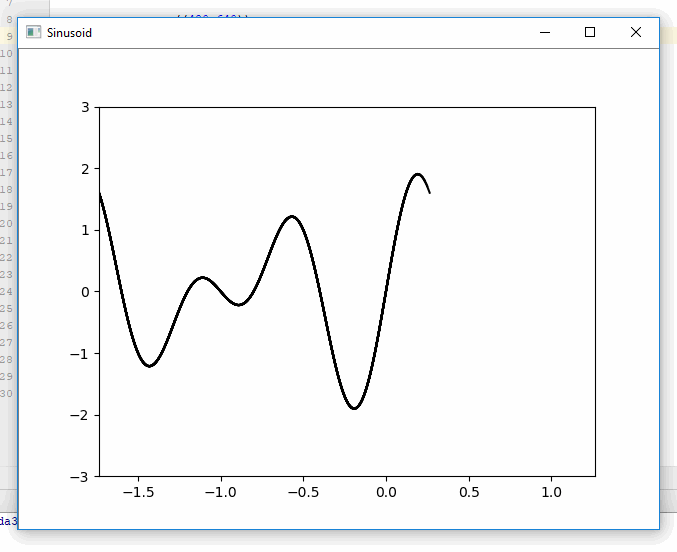Fast Live Plotting in Matplotlib / PyPlot
Solution 1:
First of all, the code that is posted in the question runs with 7 fps on my machine, with QT4Agg as backend.
Now, as has been suggested in many posts, like here or here, using blit might be an option. Although this article mentions that blit causes strong memory leakage, I could not observe that.
I have modified your code a bit and compared the frame rate with and without the use of blit. The code below gives
- 28 fps when run without blit
- 175 fps with blit
Code:
import time
from matplotlib import pyplot as plt
import numpy as np
def live_update_demo(blit = False):
x = np.linspace(0,50., num=100)
X,Y = np.meshgrid(x,x)
fig = plt.figure()
ax1 = fig.add_subplot(2, 1, 1)
ax2 = fig.add_subplot(2, 1, 2)
img = ax1.imshow(X, vmin=-1, vmax=1, interpolation="None", cmap="RdBu")
line, = ax2.plot([], lw=3)
text = ax2.text(0.8,0.5, "")
ax2.set_xlim(x.min(), x.max())
ax2.set_ylim([-1.1, 1.1])
fig.canvas.draw() # note that the first draw comes before setting data
if blit:
# cache the background
axbackground = fig.canvas.copy_from_bbox(ax1.bbox)
ax2background = fig.canvas.copy_from_bbox(ax2.bbox)
plt.show(block=False)
t_start = time.time()
k=0.
for i in np.arange(1000):
img.set_data(np.sin(X/3.+k)*np.cos(Y/3.+k))
line.set_data(x, np.sin(x/3.+k))
tx = 'Mean Frame Rate:\n {fps:.3f}FPS'.format(fps= ((i+1) / (time.time() - t_start)) )
text.set_text(tx)
#print tx
k+=0.11
if blit:
# restore background
fig.canvas.restore_region(axbackground)
fig.canvas.restore_region(ax2background)
# redraw just the points
ax1.draw_artist(img)
ax2.draw_artist(line)
ax2.draw_artist(text)
# fill in the axes rectangle
fig.canvas.blit(ax1.bbox)
fig.canvas.blit(ax2.bbox)
# in this post http://bastibe.de/2013-05-30-speeding-up-matplotlib.html
# it is mentionned that blit causes strong memory leakage.
# however, I did not observe that.
else:
# redraw everything
fig.canvas.draw()
fig.canvas.flush_events()
#alternatively you could use
#plt.pause(0.000000000001)
# however plt.pause calls canvas.draw(), as can be read here:
#http://bastibe.de/2013-05-30-speeding-up-matplotlib.html
live_update_demo(True) # 175 fps
#live_update_demo(False) # 28 fps
Update:
For faster plotting, one may consider using pyqtgraph.
As the pyqtgraph documentation puts it: "For plotting, pyqtgraph is not nearly as complete/mature as matplotlib, but runs much faster."
I ported the above example to pyqtgraph. And although it looks kind of ugly, it runs with 250 fps on my machine.
Summing that up,
- matplotlib (without blitting): 28 fps
- matplotlib (with blitting): 175 fps
- pyqtgraph : 250 fps
pyqtgraph code:
import sys
import time
from pyqtgraph.Qt import QtCore, QtGui
import numpy as np
import pyqtgraph as pg
class App(QtGui.QMainWindow):
def __init__(self, parent=None):
super(App, self).__init__(parent)
#### Create Gui Elements ###########
self.mainbox = QtGui.QWidget()
self.setCentralWidget(self.mainbox)
self.mainbox.setLayout(QtGui.QVBoxLayout())
self.canvas = pg.GraphicsLayoutWidget()
self.mainbox.layout().addWidget(self.canvas)
self.label = QtGui.QLabel()
self.mainbox.layout().addWidget(self.label)
self.view = self.canvas.addViewBox()
self.view.setAspectLocked(True)
self.view.setRange(QtCore.QRectF(0,0, 100, 100))
# image plot
self.img = pg.ImageItem(border='w')
self.view.addItem(self.img)
self.canvas.nextRow()
# line plot
self.otherplot = self.canvas.addPlot()
self.h2 = self.otherplot.plot(pen='y')
#### Set Data #####################
self.x = np.linspace(0,50., num=100)
self.X,self.Y = np.meshgrid(self.x,self.x)
self.counter = 0
self.fps = 0.
self.lastupdate = time.time()
#### Start #####################
self._update()
def _update(self):
self.data = np.sin(self.X/3.+self.counter/9.)*np.cos(self.Y/3.+self.counter/9.)
self.ydata = np.sin(self.x/3.+ self.counter/9.)
self.img.setImage(self.data)
self.h2.setData(self.ydata)
now = time.time()
dt = (now-self.lastupdate)
if dt <= 0:
dt = 0.000000000001
fps2 = 1.0 / dt
self.lastupdate = now
self.fps = self.fps * 0.9 + fps2 * 0.1
tx = 'Mean Frame Rate: {fps:.3f} FPS'.format(fps=self.fps )
self.label.setText(tx)
QtCore.QTimer.singleShot(1, self._update)
self.counter += 1
if __name__ == '__main__':
app = QtGui.QApplication(sys.argv)
thisapp = App()
thisapp.show()
sys.exit(app.exec_())
Solution 2:
Here's one way to do live plotting: get the plot as an image array then draw the image to a multithreaded screen.
Example using a pyformulas screen (~30 FPS):
import pyformulas as pf
import matplotlib.pyplot as plt
import numpy as np
import time
fig = plt.figure()
screen = pf.screen(title='Plot')
start = time.time()
for i in range(10000):
t = time.time() - start
x = np.linspace(t-3, t, 100)
y = np.sin(2*np.pi*x) + np.sin(3*np.pi*x)
plt.xlim(t-3,t)
plt.ylim(-3,3)
plt.plot(x, y, c='black')
# If we haven't already shown or saved the plot, then we need to draw the figure first...
fig.canvas.draw()
image = np.fromstring(fig.canvas.tostring_rgb(), dtype=np.uint8, sep='')
image = image.reshape(fig.canvas.get_width_height()[::-1] + (3,))
screen.update(image)
#screen.close()

Disclaimer: I'm the maintainer of pyformulas